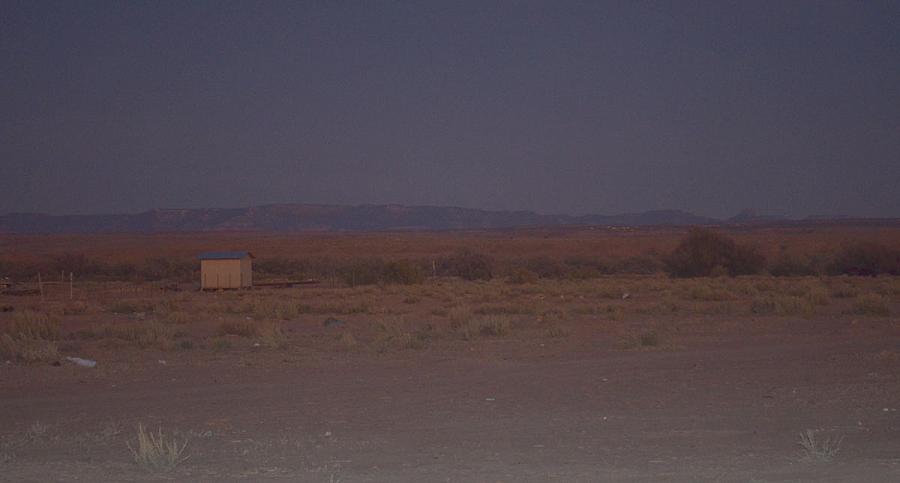How a tribal community guided an outsider to investigate asthma on the reservation

The Navajo Reservation near Many Farms, Arizona.
(Eilís O’Neill/ WHYY)
One night in the early 2000s, Christine Tsinnajinnie and her husband came home from a prayer service for a dying relative to find their son Rolando, who was not yet 2 years old, alarmingly sick.
“He was like all blue,” Tsinnajinnie remembers. “His skin was all dark and blue.”
Rolando was having a severe asthma attack.
The Tsinnajinnies live in a trailer on a hill towards the middle of the Navajo Nation territory in northeast Arizona. They’re at least half an hour from the nearest clinic. Christine says she gave her son a couple of puffs from a rescue inhaler, loaded him into the car and headed to the emergency room.
When they got there, the staff told Christine that Rolando needed an intensive care unit and pediatric pulmonologists. The nearest hospital with those resources is in Phoenix, a 5-hour drive from the Navajo Nation. Rolando needed help fast. So he and Christine boarded a medevac plane to Phoenix.
When I visited the Navajo Nation to learn more about the high asthma rates there and, in particular, the high rates of very severe asthma like Rolando Tsinnajinnie’s, I did not know how bad things were. But as I talked to families with kids who have asthma, I learned that severe attacks and middle-of-the-night medevacs to Phoenix are surprisingly common on the Navajo Nation’s land.
Now, the high rates of asthma and other respiratory illnesses have taken on a new urgency: COVID-19 has hit the Navajo Nation worse than any other tribe in the country. As of May 26, 4,689 people had tested positive for the coronavirus, and 157 had died. The Navajo community had the highest per-capita infection rate in the United States.
The importance of breath has suddenly become a national concern.
Reporting on those high asthma rates presented several challenges:
-
Finding families willing to talk to me. And, once I did, it was challenging to navigate to their homes. Most homes on the Navajo Nation don’t have addresses and are on unmarked dirt roads, so I had to call sources multiple times to make sure I was in the right place.
-
Reaching sources when I had follow-up questions as I wrote my stories. Cell reception is spotty on the reservation, so my sources’ phones didn’t necessarily even ring when I tried to call them.
-
Getting everything I needed the first time around, because returning to the Navajo Nation was a logistical impossibility for me.
I found two key solutions while reporting on the Navajo Nation:
-
I acknowledged my outsider status to all my interviewees. I let them be the experts on their community and guide me both literally (“I turn left after the blue house? Or was it a yellow house?”) and more figuratively (in explaining their community’s concerns).
-
I found that sources would often respond to texts when they could not answer their phones; texts can get through even when service is spotty.
A second piece of my story was on the Yakama Nation, in central Washington state, where asthma rates are also high. By reporting on these two communities, I hoped to spotlight how different attempts to resolve the same underlying issue could hold lessons for addressing asthma on reservations across the country.
Reporting on the Yakama Nation presented slightly different challenges:
-
Many families did not want me to visit them in their homes; one source told me that reluctance might be due to embarrassment. As a radio reporter, I usually meet with sources in their homes so I can gather ambience, get a sense for their situation, and learn a great deal more than I would by meeting in a neutral location like a coffee shop or park.
-
The Yakama Nation’s clean air agency denied my many interview requests. This meant I never got the tribal government’s take on what it is doing to improve air quality, a big step toward controlling asthma rates and severity.
On the Yakama Nation, though, I had some advantages that I did not have on the Navajo Nation:
-
The Yakama Nation’s territory is only a 3-hour drive from Seattle, where I’m based, so I was able to go back multiple times for follow-up interviews or to talk to people who weren’t available or weren’t sure they wanted to be interviewed the first time I visited.
-
The county’s clean air agency has jurisdiction over the whole Yakima Valley except the Yakama Nation’s territory, and the EPA has jurisdiction over the Yakama Nation’s air quality and works closely with the Yakama Nation’s clean air agency. Even though the Yakama Nation denied my interview requests, by talking to the EPA and the county clean air agency I was able to get a good sense of the regulatory framework, existing air quality programs, and resources that would be required to make a meaningful difference in the valley’s air quality.
-
This was obviously not ideal — I would definitely have preferred to talk to the tribal government itself for a story about the Yakama Nation — but it was a reasonable workaround.
In reporting this story and other stories on reservations, I’ve learned that, sometimes, tribal members don’t believe that you are going to come until you are there. As a result, I try not to panic too much if my whole reporting trip isn’t lined up before my arrival. Instead, I build flexibility and extra time into my reporting trip and try to have back-up options (for example, can I stand in a public location and talk to passersby?) in case things don’t work out the way I hope.
Find Eilis O’Neill’s fellowship stories here.

